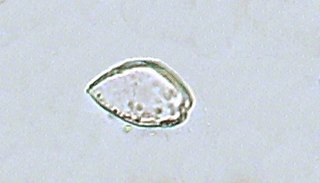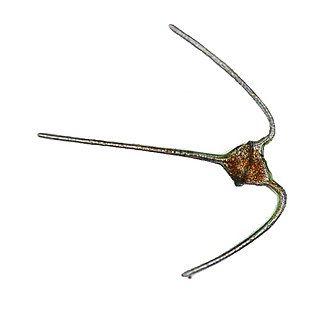
The Prorocentrales are a small order of dinoflagellates. They are distinguished by having their two flagella inserted apically, rather than ventrally as in other groups. One flagellum extends forward and the other circles its base, and there are no flagellar grooves. This arrangement is called desmokont, in contrast to the dinokont arrangement found in other groups. Accordingly, the Prorocentrales may be called desmoflagellates, and in some classifications were treated as a separate class Desmophyceae.

The genus Ceratium is restricted to a small number of freshwater dinoflagellate species. Previously the genus contained also a large number of marine dinoflagellate species. However, these marine species have now been assigned to a new genus called Tripos. Ceratium dinoflagellates are characterized by their armored plates, two flagella, and horns. They are found worldwide and are of concern due to their blooms.

Charles Atwood Kofoid was an American zoologist known for his collection and classification of many new species of marine protozoans which established marine biology on a systematic basis.

Ceratoperidinium margalefii, also known as Ceratoperidinium yeye, is a species of dinoflagellates. This species has two flagella. Their resemblance to the legs of a girl dancing inspired its original name, Ceratoperidinium yeye, in reference to the female-dominated yé-yé pop music and dance of the 1960s.

Ornithocercus is a genus of planktonic dinoflagellate that is known for its complex morphology that features considerable lists growing from its thecal plates, giving an attractive appearance. Discovered in 1883, this genus has a small number of species currently categorized but is widespread in tropical and sub-tropical oceans. The genus is marked by exosymbiotic bacteria gardens under its lists, the inter-organismal dynamics of which are a current field of research. As they reside only in warm water, the genus has been used as a proxy for climate change and has potential to be an indicator species for environmental change if found in novel environments.
Parvilucifera is a genus of marine alveolates that parasitise dinoflagellates. Parvilucifera is a parasitic genus described in 1999 by Norén et al. It is classified perkinsozoa in the supraphylum of Alveolates. This taxon serves as a sister taxon to the dinoflagellates and apicomplexans. Thus far, five species have been described in this taxon, which include: P.infectans, P.sinerae, P.corolla, P.rostrata, and P.prorocentri. The genus Parvilucifera is morphologically characterized by flagellated zoospore. The life cycle of the species in this genus consist of free-living zoospores, an intracellular stage called trophont, and asexual division to form resting sporangium inside host cell. This taxon has gained more interest in research due to its potential significance in terms of negative regulation for dinoflagellates blooms, that have proved harmful for algal species, humans, and the shellfish industry.

Ceratoperidinium is a genus of dinoflagellates in the order Gymnodiniales. The genus contains two species. It was first created in 1969 by Margalef, with Ceratoperidinium yeye as the type species. However, because it was not correctly described it was considered invalid, as was C. yeye. In 1980, Lobelich III described the genus as Ceratoperidinium Margalef ex Loeblich III, renaming C. yeye as C. margalefii. In 2014, Gyrodinium falcatum was reassigned to Ceratoperidinium based on genetic analysis.
Glenodinium is a genus of dinoflagellates with unknown classification.
Karlodinium armiger is a species of dinoflagellates belonging to the family Kareniaceae. It was first isolated from the Mediterranean sea & described in 2006.
Actiniscus is a genus of dinoflagellate belonging to the family Actiniscaceae.
Actiniscus pentasterias is a species of dinoflagellate belonging to the family Actiniscaceae.
Katodinium is a genus of dinoflagellates belonging to the family Tovelliaceae.
Kofoidinium is a genus of dinoflagellates belonging to the family Kofoidiniaceae. It only contains one known species,
Kofoidinium velleloides is a species of dinoflagellate belonging to the family Kofoidiniaceae.
Amylax is a genus of dinoflagellates belonging to the family Lingulodiniaceae.
Cochlodinium is a genus of dinoflagellates belonging to the family Gymnodiniaceae.
Dicroerisma is a genus of dinoflagellates belonging to the family Dicroerismataceae.
Lepidodinium is a genus of dinoflagellates belonging to the family Gymnodiniaceae.
Lessardia is a genus of dinoflagellates belonging to the family Lessardiaceae.
Karlodinium veneficum is a species of dinoflagellates belonging to the family Kareniaceae.





